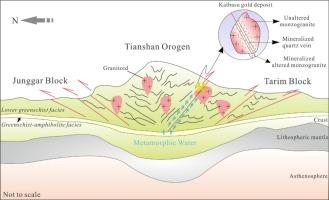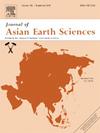Genesis of the Katbasu gold deposit in the western Tianshan, NW China: Constraints from fluid inclusions and H-O, S, and Pb isotopes
IF 2.4
3区 地球科学
Q2 GEOSCIENCES, MULTIDISCIPLINARY
引用次数: 0
Abstract
The Katbasu gold deposit, located in the western Tianshan tectonic belt of Xinjiang, China. The genesis of this deposit remains controversial. This study conducted field geological investigations, fluid inclusion (FIs) studies, and stable isotopes (H-O, S, and Pb) analyses. The results indicate that the host rocks exhibit pyritization, the ore minerals are dominated by pyrite with minor chalcopyrite, sphalerite, galena, and native gold. The hydrothermal mineralization period can be divided into three stages: quartz-pyrite veins (early stage), native gold-polymetallic sulfide-quartz veins (middle stage), and quartz-carbonate veins (late stage). The homogenization temperatures of FIs for the early, middle, and late stages are 296.6–344.4℃, 206.4–297.7℃, and 146.7–199.2℃, respectively. The corresponding salinities range from 9.74–12.55 wt%, 5.26–11.61 wt%, and 3.71–5.56 wt%, with densities of 0.76–0.85 g/cm3, 0.77–0.90 g/cm3, and 0.90–0.95 g/cm3. The δ18Ofluid values range from 3.2 to 3.6 ‰, while the δD values range from −93.4 to −98.1 ‰. The H-O isotopic indicates that the ore-forming fluids were primarily derived from metamorphic water, with involvement of meteoric water. The δ34SH2S values range from 7.08 ‰ to 9.78 ‰, with 206Pb/204Pb ratios of 18.26 to 19.38, 207Pb/204Pb ratios of 15.60 to 15.65, and 208Pb/204Pb ratios of 38.17 to 38.49. The S and Pb isotopic suggest that the metamorphic stratigraphy played a significant role. Based on previous studies, FIs data, and isotopic compositions of H-O, S, and Pb, the Katbasu gold deposit is classified as an early skarn-type magmatic-hydrothermal deposit and was subsequently overprinted by an orogenic-type gold deposit.

西天山喀巴苏金矿床成因:流体包裹体和H-O、S、Pb同位素的约束
喀巴苏金矿床位于新疆天山构造带西段。这个矿床的成因仍有争议。本研究进行了野外地质调查、流体包裹体(FIs)研究和稳定同位素(氢氧、硫和铅)分析。结果表明,金矿主岩呈现黄铁矿化特征,矿石矿物以黄铁矿为主,少量黄铜矿、闪锌矿、方铅矿和自然金。热液成矿期可分为3个阶段:石英-黄铁矿脉(早期)、原生金-多金属硫化物-石英脉(中期)和石英-碳酸盐脉(晚期)。FIs前期、中期、后期均质温度分别为296.6 ~ 344.4℃、206.4 ~ 297.7℃、146.7 ~ 199.2℃。相应的盐度范围为9.74 ~ 12.55 wt%、5.26 ~ 11.61 wt%和3.71 ~ 5.56 wt%,密度为0.76 ~ 0.85 g/cm3、0.77 ~ 0.90 g/cm3和0.90 ~ 0.95 g/cm3。δ18Ofluid值为3.2 ~ 3.6‰,δD值为−93.4 ~−98.1‰。氢氧同位素表明成矿流体主要来源于变质水,并有大气降水的参与。δ34SH2S值为7.08‰~ 9.78‰,206Pb/204Pb比值为18.26 ~ 19.38,207Pb/204Pb比值为15.60 ~ 15.65,208Pb/204Pb比值为38.17 ~ 38.49。S、Pb同位素特征表明,变质地层起了重要作用。综合前人研究、FIs资料及H-O、S、Pb同位素组成,认为Katbasu金矿床为早期矽卡岩型岩浆热液型金矿床,后被造山带型金矿床叠印。
本文章由计算机程序翻译,如有差异,请以英文原文为准。
求助全文
约1分钟内获得全文
求助全文
来源期刊

Journal of Asian Earth Sciences
地学-地球科学综合
CiteScore
5.90
自引率
10.00%
发文量
324
审稿时长
71 days
期刊介绍:
Journal of Asian Earth Sciences has an open access mirror journal Journal of Asian Earth Sciences: X, sharing the same aims and scope, editorial team, submission system and rigorous peer review.
The Journal of Asian Earth Sciences is an international interdisciplinary journal devoted to all aspects of research related to the solid Earth Sciences of Asia. The Journal publishes high quality, peer-reviewed scientific papers on the regional geology, tectonics, geochemistry and geophysics of Asia. It will be devoted primarily to research papers but short communications relating to new developments of broad interest, reviews and book reviews will also be included. Papers must have international appeal and should present work of more than local significance.
The scope includes deep processes of the Asian continent and its adjacent oceans; seismology and earthquakes; orogeny, magmatism, metamorphism and volcanism; growth, deformation and destruction of the Asian crust; crust-mantle interaction; evolution of life (early life, biostratigraphy, biogeography and mass-extinction); fluids, fluxes and reservoirs of mineral and energy resources; surface processes (weathering, erosion, transport and deposition of sediments) and resulting geomorphology; and the response of the Earth to global climate change as viewed within the Asian continent and surrounding oceans.
 求助内容:
求助内容: 应助结果提醒方式:
应助结果提醒方式:


